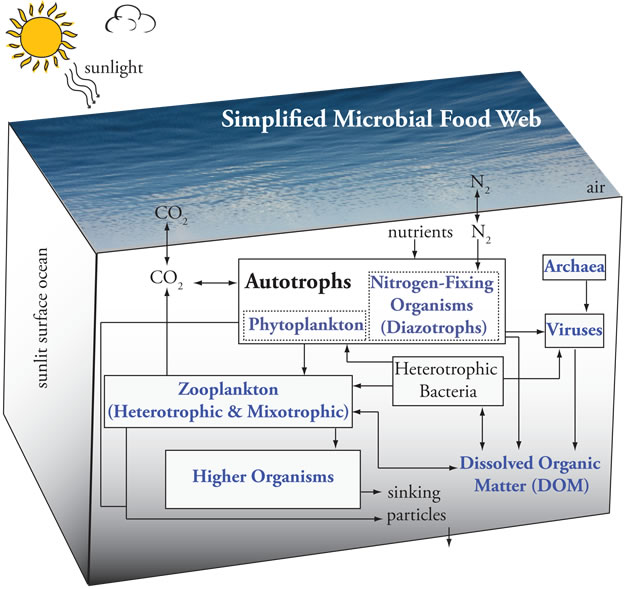- C-MORE Home
- Member Area
- What is Microbial Oceanography?
- What is C-MORE?
- C-MORE Hale
- Research
- Research Cruises
- Data
- Education & Outreach
- People
- Publications
- Microscopy Images
- Professional Development Training Program
- Summer Course
- C-MORE Highlights
- Meeting Facilities
- Contact Us
C-MORE Microscopy
The ocean contains a universe of small wonders, an interconnected web of life. Marine microbes are the root of all this life. Below is a simplifed version of how energy and matter are transferred in the ocean. Each box represents a general class of organisms, for example autotrophs. Arrows indicate the transfer of elements and energy between these boxes. Click on one of the boxes in the image below to see a slideshow of the organisms that comprise each group or scroll down to learn more.

Phytoplankton
Phytoplankton is a general term encompassing all autotrophic organisms. The word phytoplankton is derived from the Greek words 'phyton' or plant and 'planktos', meaning to drift. These microorganisms use the energy of the sun, carbon dioxide and nutrients dissolved in seawater to produce organic matter via photosynthesis. This process, termed primary production, can result in the drawdown and sequestration of carbon dioxide from the atmosphere. In the marine environment, typical phytoplankton include diatoms (algae encased in a silica shell), coccolithophores (algae often encased in calcium carbonate liths) and cyanobacteria. Click here to see a slideshow of marine phytoplankton.
Nitrogen-fixers
Nitrogen (N) is an essential ingredient in the recipe for life. It is needed as a building block for proteins, nucleic acids and other cell components. However in the open ocean, where most microbes require 'fixed' or combined sources of nitrogen (nitrate, ammonium, or organic compounds), the availibility of N can limit productivity. There are a special class of prokaryotic microorganisms that can get around this potential limitation by tapping into the relatively limitless pool of di-nitrogen that is dissolved in surface seawater. The productivity of these nitrogen fixing organisms can relieve N limitation in surface waters and impact net community productivity.Click here to see slideshow of a nitrogen-fixing organisms.
Grazers: Zooplankton and More
A colorful and varied assortment of organisms directly rely on microbes as a source of nutrition. Collectively, these organisms are termed 'grazers' or zooplankton. Zooplankton include protozoans such as flagellates and ciliates as well as small crustaceans called copepods. A variety of feeding mechanisms and preferences exist among the zooplankton. Some organisms capture individual phytoplankton (e.g. chaetognaths), others filter large volumes of water in order to concentrate their food (e.g. certain copepods) while yet others engulf food particles whole via phagocytosis. And finally there are also mixotrophs, capable of both phototrophy and phagocystis, thus having one 'foot' in the autotroph box and another in the grazer box. Grazers are especially important as a food source for higher organisms and as link in the transport of carbon to the deep ocean. Click here to see a slideshow of zooplankton.
Higher Organisms
Beyond the microbial work-horses of the marine environment, there are the many creatures that depend on the productivity of the base of the food chain. This 'box' encompasses wide-eyed juvenile squid and crab as well as the fish that end up on our dinner plates. Click here to see slideshow of a selection of higher organisms.
Viruses
Viruses are the most numerous biological entities in aquatic ecosystems, with concentrations 3 to 10 times higher than bacteria. Most viruses are thought to infect bacteria and phytoplankton. Viruses have been shown to significantly impact microbial ecology and evolution, global biogeochemistry, and cycling of organic matter by serving variously as agents of microbial mortality, phenotypic conversion, and horizontal gene transfer. Viral lysis results in the death of the host and subsequent release of the host’s cellular contents to the dissolved organic matter pool, thus resulting in less food available for grazers and increased recycling of dissolved organic matter by bacteria. Aquatic viruses are also incredibly diverse with respect to their size, shape, and genomic structure. They are capable of horizontally transferring genes between hosts, thus altering the evolution of aquatic microorganisms. Click here to see slideshow of viruses.
Symbiotic Associations: Bridging Relationships
Many protists in the open ocean live together with cyanobacteria in presumed mutualistic relationships. These symbioses are diverse, and include a variety of unicellular eukaryotic hosts of dinoflagellates, tintinnids, radiolarians, and diatoms. The basis of the relationships are largely unresolved, and since the symbionts are photosynthetic and some diazotrophic, the symbiont likely functions as a carbon and/or nitrogen source for the host. The benefit (if any) to the symbiont is unknown. Click here to see a slideshow of marine symbioses.
Heterotrophic Bacteria
Description coming soon
[ Top of Page ]



